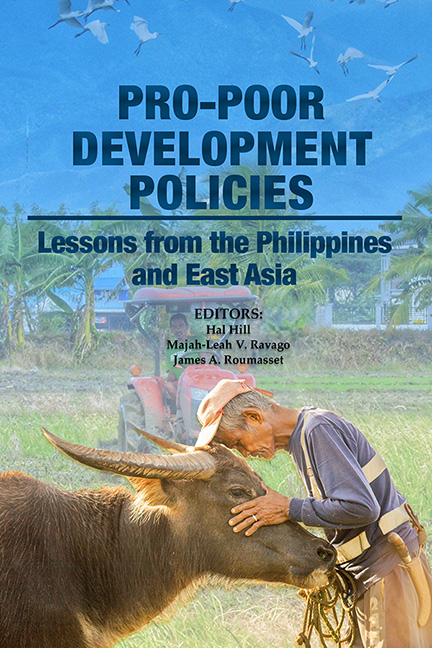Book contents
- Frontmatter
- Dedication
- Contents
- Figures, Tables and Boxes
- Foreword
- Foreword
- Message
- Preface and Acknowledgements
- About the Editors
- About the Contributors
- Acronyms
- Part 1 Introduction and Synthesis
- Part 2 Agricultural and Economic Development
- Part 3 Economic Policies for Achieving Targeted Levels of Living in the Philippines
- Part 4 Inequality and Economic Development
- Part 5 Competition Law and Policy
- Part 6 International Dimensions
- Index
4 - Beyond Krugman: The Importance of Agriculture for East Asian Growth
Published online by Cambridge University Press: 09 January 2024
- Frontmatter
- Dedication
- Contents
- Figures, Tables and Boxes
- Foreword
- Foreword
- Message
- Preface and Acknowledgements
- About the Editors
- About the Contributors
- Acronyms
- Part 1 Introduction and Synthesis
- Part 2 Agricultural and Economic Development
- Part 3 Economic Policies for Achieving Targeted Levels of Living in the Philippines
- Part 4 Inequality and Economic Development
- Part 5 Competition Law and Policy
- Part 6 International Dimensions
- Index
Summary
INTRODUCTION
Paul Krugman’s 1994 Foreign Affairs article, “The Myth of Asia’s Miracle”, is one of the most widely read and debated essays ever written by an economist. In this justly famous polemic, Krugman debunks the notion that the rapid economic growth occurring in much of Asia over the two decades from the mid-1970s to the mid-1990s was attributable to forces that defy conventional economic logic. He contends instead that the source was boringly conventional, but also unsustainable. His conceptual target is summarized in the title of an influential World Bank report of the previous year, The East Asian Miracle. According to Krugman, there was no miracle. He was right about that, but wrong about the true sources of Asia’s growth.
The analytical basis for Krugman’s discussion is growth accounting, an approach to understanding the sources of economic growth that rests on the distinction between growth of output deriving from increases in the quantities of inputs employed and increases in the amount of output obtained per unit of these inputs—their productivity. The seminal contribution of Robert Solow (1957) relates the growth of output per worker in the United States to the growth of the capital stock per worker. Solow estimates that only 12.5 per cent of the long-term increase in the former was due to increases in the latter. The remaining 87.5 per cent was an unexplained residual, which Solow identifies as technical change.
According to Krugman, the empirical evidence assembled by earlier studies on East Asia reveals that, in contrast with Solow’s findings for the United States, Asia’s rapid per capita growth was due almost entirely to growth in the quantity of factor inputs employed per head of population, which he calls “perspiration”. The “perspiration” had two components: increases in the size of the workforce per head of population—labour force participation—and increases in the quantities of capital inputs applied per worker. These capital inputs consisted of physical capital (in the form of machines, buildings and public infrastructure), and human capital (in the form of education and vocational training). When all these inputs were accounted for, the difference between the actual growth of output per worker and the growth attributable to increases in the quantity of inputs applied per worker—Solow’s residual productivity growth, which Krugman calls “inspiration”—was negligible.
- Type
- Chapter
- Information
- Pro-poor Development PoliciesLessons from the Philippines and East Asia, pp. 95 - 115Publisher: ISEAS–Yusof Ishak InstitutePrint publication year: 2022



